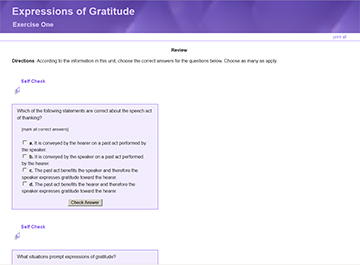Unit 1 Introduction
Unit 1 presents a brief introduction to expressions of gratitude and explains the necessity and importance of learning how to appropriately express gratitude in Chinese. This unit also provides corresponding exercises and activities for students to practice.
1.1 Goal of Unit 1
The goal of Unit 1 is to engage students' interest and attention to expressions of gratitude and to make them understand the importance of appropriate use of gratitude in everyday communication. In addition, this unit provides students with examples that illustrate the use of Chinese expressions of gratitude in daily life.
1.2 What is the Speech Act of Thanking?
The speech act of thanking is concerned with how we express gratitude in communication. The expression of gratitude is conveyed by the speaker on a past act performed by the hearer. The speaker believes he/she benefited from the act and feels appreciative or indebted toward the hearer, and thus makes a statement which expresses his/her appreciation (Eisenstein & Bodman, 1986). Gratitude can be expressed in response to various situations such as receiving a gift, favor, reward, or service.
In American English, the most commonly used expression of gratitude is “thank you/thanks” while in Chinese, the most common form of expressing appreciation is 谢谢 xièxiè.
Thinking: Can you think of other situations that you should express gratitude in everyday communication in addition to receiving a gift, favor, reward or service?
1.3 Why Teach Gratitude?
Expressing gratitude is an important social function in all languages and cultures. When performed appropriately, an expression of gratitude can successfully enhance friendly feelings between interlocutors, whereas inappropriate expression may result in misunderstanding or very negative social consequences (Bodman & Eisenstein, 1988; Eisenstein & Bodman, 1986). Especially for foreign language learners, it is important to establish warm and harmonious relationships with native speakers. However, little scholarly attention has been paid to learners’ performance of gratitude, and in particular to Chinese expressions of gratitude.
Previous cross-cultural studies have found noticeable differences between expressions of gratitude in American English and in Chinese (e.g., Bi, 1996b; Li, 2004; Liu, 2004). For instance, some thanking strategies (i.e., linguistic expressions used to express gratitude) are specific to Chinese, such as the strategy of showing care. For example, when Chinese speakers receive a favor, they often show care and consideration toward the person who has offered help to express their appreciation, like 你一定累坏了, 休息一下 (Nǐ yídìng lèi huài le, xiūxi yíxià. You must be worn out and should have a rest). This way of expressing gratitude often causes misunderstanding for people who are not familiar with the use of thanking strategies in Chinese.
In particular, for American learners who study Chinese as a foreign language, they are generally exposed to insufficient pragmatic input outside foreign language classrooms, so it is important to explicitly teach students about these differences. And this is one of the goals this instructional website is aimed at achieving.
Thinking: What do you think of the necessity and importance of learning how to express gratitude appropriately in Chinese?
Exercise One
Please complete the following Review here.
